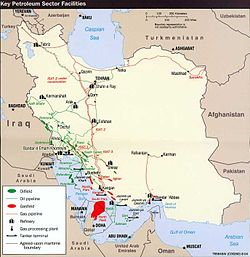| سازمان انرژی اتمی | |
 The AEOI logo | |
| Established | 1974 |
|---|---|
| Type | Organization |
| Legal status | Active |
| Headquarters | North Karegar Avenue, Tehran, Iran |
Head | Mohammad Eslami |
| Website | www.aeoi.org.ir |
| Part of a series on the |
| Nuclear program of Iran |
|---|
 |
| Timeline |
| Facilities |
| Organizations |
| International agreements |
| Domestic laws |
| Individuals |
| Related |
|
The Atomic Energy Organization of Iran (AEOI) is the main Iranian government agency responsible for operating nuclear energy and nuclear fuel cycle installations in Iran. The AEOI is the primary organization responsible for nuclear technology research and development activities in Iran. [1] The AEOI was involved in formerly undeclared nuclear activities including enrichment facilities at Fordow and Natanz. [2]
Contents
- Nuclear power plans
- Schools
- Research centers
- Divisions
- Presidents
- See also
- References
- External links
The AEOI's headquarters are in the northern Amir Abad district in Tehran, but it has facilities throughout Iran. The current head of the AEOI is Mohammad Eslami, who replaced Ali Akbar Salehi on 29 August 2021. [3] By 2024, Iran's nuclear industry sector employed more than 25,000 specialists, [4] of which around 40% were women. [5]
